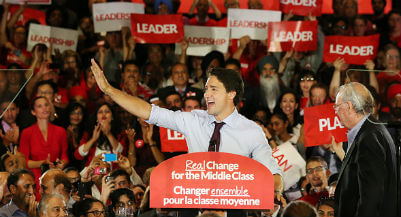The real winners of the new Liberal tax policies
We crunched the numbers. Low and middle-income families will actually come out ahead
Advertisement
We crunched the numbers. Low and middle-income families will actually come out ahead

| Provision | Current Rules | New Rules | Difference |
| Federal Tax | $11,885.35 | $10,959.87 | +$925 |
| Family Tax Cut | $2,000 | $0 | -$2,000 |
| UCCB | $2,640 | $0 | -$2,640 |
| CCB | $1,330 | $5,150 | +$3,820 |
| Total | $105 | ||
| Provision | Current Rules | New Rules | Difference |
| Federal Tax | $8,585.24 | $8,189.24 | +$396 |
| Family Tax Cut | $0 | $0 | $0 |
| UCCB | $2,640 | $0 | -$2,640 |
| CCB | $1,330 | $5,150 | +$3,820 |
| Total | $1,576 | ||
| Provision | Current Rules | New Rules | Difference |
| Federal Tax | $8,808.11 | $8,189.24 | +$619 |
| Family Tax Cut | $920.22 | $0 | -$920.22 |
| UCCB | $2,640 | $0 | -$2,640 |
| CCB | $1,330 | $5,150 | +$3,820 |
| Total | $878.78 | ||
| Provision | Current Rules | New Rules | Difference |
| Federal Tax | $2,442.19 | $2,046.19 | +$396 |
| Family Tax Cut | $0 | $0 | $0 |
| UCCB | $2,640 | $0 | -$2,640 |
| CCB | $4,022 | $10,500 | +$6,478 |
| Total | $4,234 | ||
| Provision | Current Rules | New Rules | Difference |
| Federal Tax | $41,011.12 | $39,049.75 | +$1,961 |
| Family Tax Cut | $0 | $0 | $0 |
| UCCB | $2,640 | $0 | -$2,640 |
| CCB | $0 | $0 | $0 |
| Total | -$679 | ||
| Provision | Current Rules | New Rules | Difference |
| Federal Tax | $15,134.86 | $14,605.38 | +$529 |
| Family Tax Cut | $0 | $0 | $0 |
| UCCB | $0 | $0 | $0 |
| CCB | $0 | $0 | $0 |
| Total | $529 | ||
| Provision | Current Rules | New Rules | Difference |
| Federal Tax | $4,644.01 | $4,644.01 | $0 |
| Family Tax Cut | $0 | $0 | $0 |
| UCCB | $0 | $0 | $0 |
| CCB | $0 | $0 | $0 |
| Total | $0 | ||
| Provision | Current Rules | New Rules | Difference |
| Federal Tax | $9,888.40 | $9,508.92 | +$379 |
| Family Tax Cut | $0 | $0 | $0 |
| UCCB | $0 | $0 | $0 |
| CCB | $0 | $0 | $0 |
| Total | $379 | ||
| Provision | Current Rules | New Rules | Difference |
| Federal Tax | $59,254.79 | $60,587.79 | -$1,330 |
| Family Tax Cut | $0 | $0 | $0 |
| UCCB | $0 | $0 | $0 |
| CCB | $0 | $0 | $0 |
| Total | -$1,330 | ||
Share this article Share on Facebook Share on Twitter Share on Linkedin Share on Reddit Share on Email